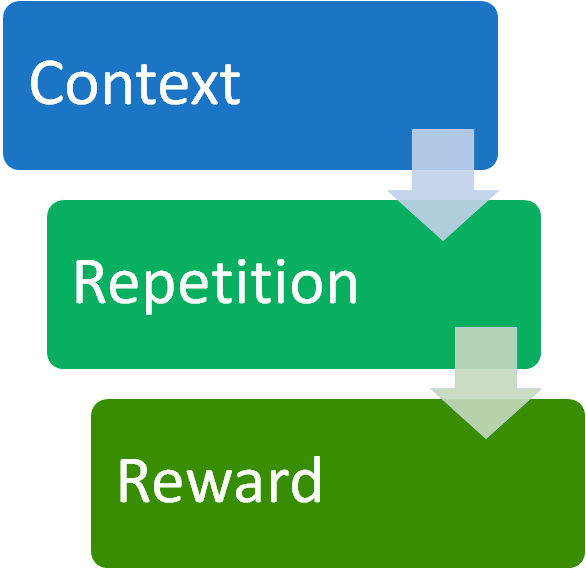“The more of the details of ordinary life we can hand over to the effortless custody of automatism, the more our higher power of mind will be set free for their own proper work.” – William James, psychologist
In my last post, I introduced readers to Dr. Wendy Wood’s book Good Habits, Bad Habits and the concept of two minds – one geared toward active cognition, and the other driven by force of habit. The latter are forged when we inculcate a behavior in response to a specific context/cue in anticipation of a reward. In time, the behavior becomes so automatic that our reasons for acting and the expected outcome become unimportant. We get triggered and go on autopilot.
 If we want to get rid of a bad habit, neither knowledge nor willpower provide much help. Context is king. As a case in point, roughly half of all American adults were smokers in the 1950s. A Reader’s Digest article published in 1952 warned of its deleterious effects. The Surgeon General published a damning report in 1964 which gave rise to warning labels on all cigarette packs. Yet by the early 1970s, 40% of American adults still lit up. With the passage of the Public Health Cigarette Smoking Act in 1970, cigarette manufacturers were prohibited from advertising or selling their products via vending machines. Airplanes, public transit services, and commercial buildings gradually migrated to nonsmoking status making it inconvenient to smoke. This sea change in context drove the smoking population down to 15% today.
If we want to get rid of a bad habit, neither knowledge nor willpower provide much help. Context is king. As a case in point, roughly half of all American adults were smokers in the 1950s. A Reader’s Digest article published in 1952 warned of its deleterious effects. The Surgeon General published a damning report in 1964 which gave rise to warning labels on all cigarette packs. Yet by the early 1970s, 40% of American adults still lit up. With the passage of the Public Health Cigarette Smoking Act in 1970, cigarette manufacturers were prohibited from advertising or selling their products via vending machines. Airplanes, public transit services, and commercial buildings gradually migrated to nonsmoking status making it inconvenient to smoke. This sea change in context drove the smoking population down to 15% today.
Contexts create forces that trigger cravings and/or habits. We’ll use up a lot of energy if we try to resist. Or, we may succumb to old patterns before noticing that they’ve engaged. It turns out that we’re so obsessed with the power of decision-making that we underestimate how much our actions are affected by our environments.
Proximity wields tremendous power. We’re drawn to what is visible and easily accessible. If you want to quit smoking or eat less, steer clear of temptation. Don’t walk down the grocery aisles that feature forbidden foods. Steer clear of the hors d’oeuvre table. We’re also profoundly influenced by people in close orbit. We do what they do (or don’t do). If their example chronically sabotages our efforts, it may be time to adjust our social circles.
We can also serve our best interests by making effective use of friction. We can reduce the friction that holds us back from exercising good habits – like exercise. Either roll out of bed and get it done without thinking, or find a gym that’s on the flight path to or from work. We want to increase friction toward things we don’t want to do. For example, I don’t keep ice cream in the house. When those cravings strike, I’d have to make the effort to go to the store to buy it, and, far more often than not, I won’t bother.
Repetition is our friend when establishing forwarding habits. We must willfully decide to repeat a behavior again and again and again until it becomes second nature. Contrary to popular belief, it takes more than 21 days to lock and load a new behavior. For example, habitually eating healthy food takes ~65 days, on average; exercising regularly takes longer (~91 days). The more complex the habit, the more time and effort it takes to get in the groove.
Of course, we’re not blank slates when trying to forge new habits. Wood describes our days as “a squabble of contradictory habits happening just under the surface of our consciousness.” As such, we need to fight off the pull of old habits while trying to install new ones. Changing contexts works in our favor because it disrupts the cues that otherwise send us headlong into action. If that’s not possible, we can slow down the pace of life to notice what we’re doing (and why we’re doing it) before taking action.
Rewards matter. As Wood says, “context will smooth the way, and repetition will jump start the engine, … but reward gets habits to operate on their own.” When experienced right after the associated action, rewards set up a neural basis for habit formation through the release of dopamine. It stamps the details of the rewarding experience into memory. In the best case scenario, rewards are an intrinsic part of the activity itself. Preparing savory, healthy food delights the palate. Exercising releases endorphins that elevate mood. Exercising with friends combines a wonderful social experience with an activity for which our bodies will thank us.
So, rather than relying on knowledge or willpower, let’s exercise our creativity in setting up our contexts, behaviors, and reward systems to achieve our goals on autopilot!